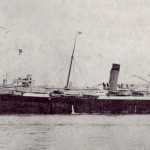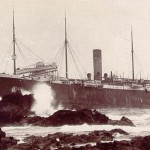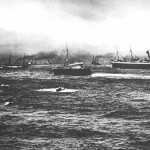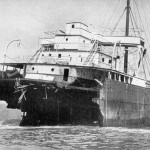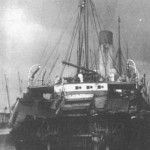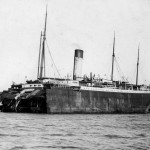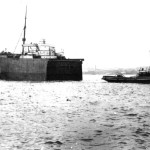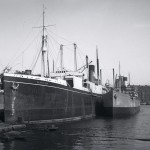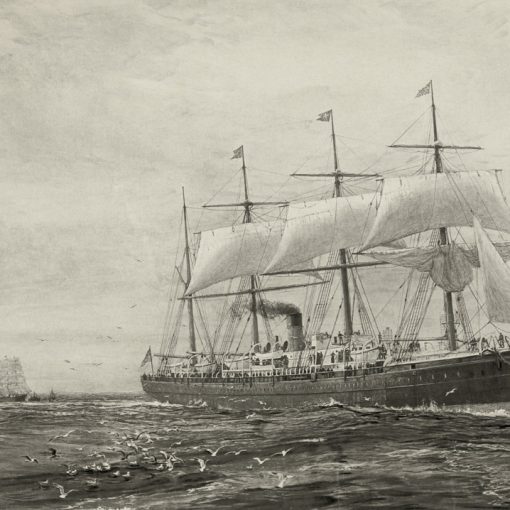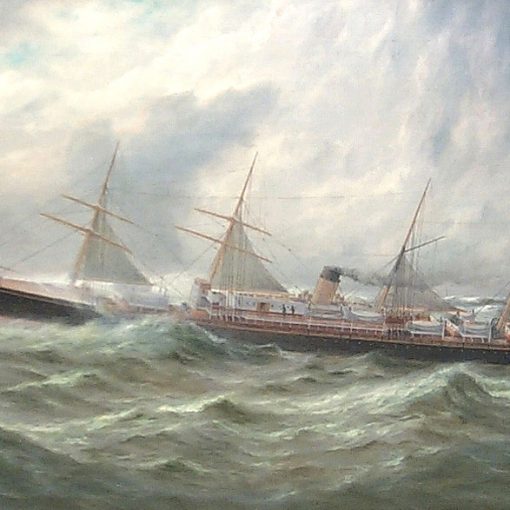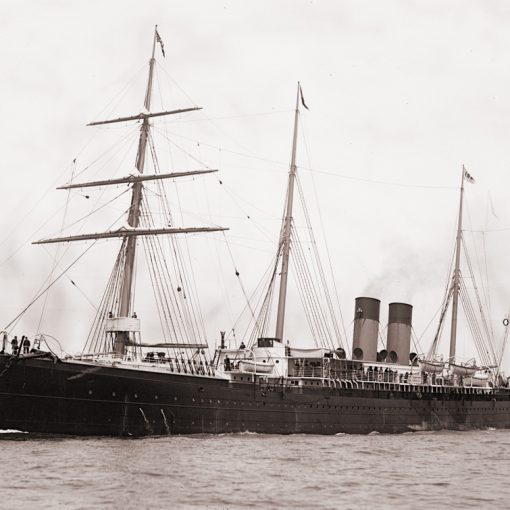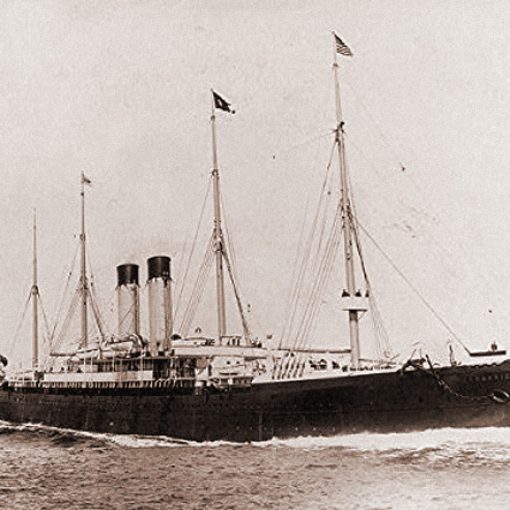1901 – 1942
When the 20th century began, the White Star Line was one of the most prominent liner companies of the seas. On the North Atlantic run, which was the most prestigious one, the company had among other ships their flagship Oceanic, which had entered service in 1899.
The White Star Line had also opened up a new route in 1899, a route between Liverpool, Cape Town and Sydney. Three ships had been built for this new trade. They were the Afric, Medic and Persic. All of these three ships were slightly below than 12,000 tons and could carry 320 passengers each, all in third class. Because they all had been launched in the last year of the 19th century, these three vessels were popularly known as ‘The Jubilee Class’.
With the death of Thomas Henry Ismay on November 23rd 1899, the control of the company was given to his son, Bruce Ismay. Before his father’s death it had been decided that the Jubilee-trio would be expanded to a quintet, and therefore Bruce Ismay ordered two more ships from the ever-reliable Harland & Wolff, Belfast.
The first ship of this additional pair was the Runic, which was launched on October 25th, 1900. As the fourth ship of the Jubilee-class she was also the largest of the four, at 12,482 tons. As with the initial Jubilee-trio, the Runic sported a single funnel and four masts, but some design modifications had been made. The two most noticeable changes were that the poop deck had been lengthened and the bridge had been placed closer to the bow. This gave the Runic a more modern look than her three older siblings.
A little less than two months later, on December 8th, the last of the Jubilee-quintet took to the water. With the same design as the Runic, she was christened Suevic and was the largest of the five, surpassing the Runic by some 50 tons. As her four consorts, she was designed to carry both passengers and cargo. The ship contained seven cargo holds and could carry as much as 400 passengers, all steerage.
After her fitting out was completed, the Suevic left on her maiden voyage to Australia on March 23rd, 1901. By now the Boer War was raging in South Africa, and the Suevic were used to carry troops to the area of hostilities along with her four siblings. Not a very noticeable ship, the Suevic had a service speed of 13 ½ knots, and would surely have received very little attention if it weren’t for an event that would occur six years later.
On March 17th 1907, the Suevic was inbound for Plymouth with a near full cargo and 382 passengers on board. Steaming along in dense fog, her master made a critical error and miscalculated her position by more than 16 miles. When the crew was looking for the Lizard light in the distance, it suddenly appeared close on the ship’s port side. With a violent force, the Suevic ran ashore at full speed. When the ship had settled on the shore, the passengers were evacuated in the ship’s lifeboats.
The Suevic was surely in a predicament. The bow was impaled on the shore, and to set it free it had to be lightened. On March 20th, the ship’s crew therefore began transferring cargo from the bow holds to small coastal steamers that had by now come to the assistance. This attempt of freeing the ship could have succeeded, had it not been for the weather.
One week later, on March 27th, the weather worsened and pushed the Suevic further onto the ledge. Seeing that the stern portion of the ship was still intact, the White Star Line decided to save the ship by severing her. By using dynamite, the bow was blown free from the rest of the ship at the bulkhead just aft of the bridge. The work was a battle against the clock, as worse weather was expected.
On April 4th, the now crippled Suevic was made seaworthy. Travelling astern by the assistance of the tugs Blazer, Herculaneum, Linnet and Ranger, the ship now set off on her journey towards Southampton. At the same time, a new bow was being constructed in the yards of Harland & Wolff. When completed, this 212 feet bow section was launched head first, and it was jokingly said that the Suevic was the longest ship in the world, her stern being in Southampton and her bow in Belfast. The bow was then towed to Southampton by the Pathfinder and Blazer on October 19th, 1907.
On October 26th, the new bow section arrived at Southampton and the work of putting the two pieces together got underway. It was the largest rebuilding operation ever undertaken, and the Suevic was ready for service again 18 months after her grounding, on January 14th, 1908. It was a remarkable achievement for this time; virtually half the ship had been renewed.
Six years later, in 1914, the First World War erupted. Because of their frozen meat capacity, the Suevic and her four consorts were kept in commercial service, carrying troops at the same time. In March 1915, the Suevic made a single trooping voyage to Mudros in the Mediterranean, as part of the Dardanelles campaign. For the duration of the war, the Suevic served the British Empire under the Liner Requisition Scheme until 1919. When she was returned to White Star, they decided that the Suevic deserved a refit.
In January 1920, the Suevic was returned to her regular route to Australia. Her passenger accommodations had been modified, and she could now carry 266 people in second class. For the next four years the Suevic remained in this service, completing her 50th voyage to Australia in March 1924.
Another four years later, in 1928, the Suevic was showing signs of her age, and was sold to the Norwegian company Yngvar Hvistendahl’s Finnvahl A/S for £35,000. In their hands she was renamed Skytteren, and was sent off to Krupp’s Germaniawerft in Kiel, where she was to be converted into a whale factory ship. She remained with the company through the years, and in 1939, she saw the beginning of yet another world war.
After the German invasion of Norway in 1940, Skytteren was interned in the Swedish port of Göteborg in April that same year along with several other Norwegian ships. The now exiled Norwegian government was in London, and claimed the ships as their property. The Quisling government objected, but a court of law found in favour of the exiled owners.
On April 1st 1942, the Norwegian ships left Göteborg to perform a dash into Allied waters. There they were to be met and protected by British vessels. The operation was a complete failure. The Germans had been alerted, and were lying in wait in the open sea. Of all the ships that had been in the convoy, only two made it past the enemies. Six were sunk by German warships, three ships turned back to Göteborg and the Skytteren was scuttled in the waters off Måseskär, Sweden, and her crew was taken as prisoners of war. That was the end of the former Suevic, and the wreck remains today where it once went down, off the coast of Sweden. She lies on her port side with her bow pointing westward.
Specifications
- 565 feet (172.6 m) long
- 63.3 feet (19.3 m) wide
- 12,531 gross tons
- 2×4 cylinder quadruple-expansion engines turning two propellers
- 13.5 knot service speed
- Passenger capacity of 400 people as originally built, changed to 266 during 1920 refit

